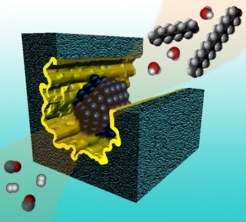Selective Conversion of Synthesis Gas

Synthesis gas, a mixture comprising primarily carbon monoxide and hydrogen, can be obtained from natural gas or lignocellulosic biomass raw materials, and then be catalytically converted into hydrocarbons through the so-called Fischer-Tropsch synthesis. Almost one century after its discovery at our institute, this reaction receives currently renewed technological and scientific interests. In particular, incentives exist to expand its scope to exploit unconventional, delocalized carbon resources such as biomass or off-shore natural gas wells. Such diversification requires a significant re-conception of the process, which in turn calls for novel reactor and catalyst designs. Another remaining challenge is the development of solid catalysts able to effectively and selectively produce high value-added, long-chain oxygenated compounds, rather than hydrocarbons. Our task is to glean fundamental understanding on the relationships between the structure of solid catalysts (at different length scales) and their performance, as a means to devise advanced catalysts able to maximize the selectivity to given target products. Particular emphasis is placed on understanding the impact of catalyst porosity and related mass transport phenomena on the ultimate performance.
